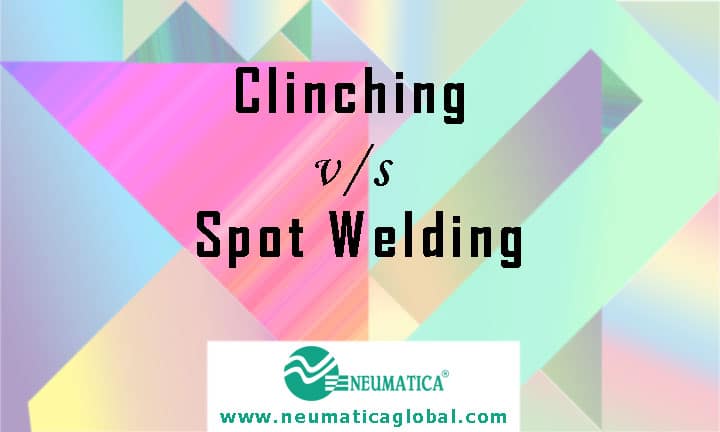In the present day scenario the use of technology and development of technology has increased rapidly. There have been new technologies and techniques which have replaced traditional methods. This article highlights the basic definition, pros and cons of Clinching v/s Spot Welding, and how to choose the best practice.
Resistance Spot Welding commonly known as Spot Welding, has been a common joining procedure since the 1930s, widely adopted in a wide variety of industries, primarily the sheet metal industry like HVAC, Appliances manufacturing, etc.
Spot welding is a joining procedure in which two metal sheets are joined due to the resistance to electric current. However, over the years, Clinching has caught on as a more viable alternative to Spot Welding for specific applications. In this article, we will try to bring out the pros and cons of Spot Welding and Clinching and deciding on the right one for you.
What is Spot Welding?
Spot Welding is a joining process in which two similar metal sheets are fused due to the resistance to the electric current. This process creates a flush surface and leaves no visible projections. An ideal spot weld creates a very good joint.
What is Clinching?
Clinching is a process of joining two similar or dissimilar metal sheets which are plastically joined due to the application of a load often without any additional material(s). A good clinch is slightly weaker than a good weld. A good clinch is about 75-80% as strong as an ideal weld.
Since we have addressed the elephant in the room, let’s move on to more practical questions. How do I decide what the right choice for me is?
Unfortunately, there are no clear distinctions in terms of the applications for the two processes and are often interchangeable. There are a few pros and cons for both the methods, and often it is the user who decides which process better suits his/her demands.
Pros of Spot Welding:
Because spot welding has been around for about 90 years, the price has fallen quite a bit.
- Most spot welding machines cost about half as much as an entry-level, floor-model clinching machine.
- The strength of an ideal spot weld is excellent. An ideal spot weld is achieved using clean tips, optimal heat, squeeze, and weld settings.
- Spot welding ensures a flush surface on the metal, whereas a clinched joint will have a dimple on one side and a projection on the other.
Cons of Spot Welding:
- One major setback in spot welding is it is quite tricky, if not impossible, to spot weld dissimilar materials.
- Testing the strength of a joint is quite difficult. There is no way to ensure that a good weld is formed other than its visual appearances or by destroying a part of the material to ensure a proper molten nugget is formed.
- Due to the enormous amounts of heat generated, surfaces of the elements get burned and become porous. These surfaces tend to invite corrosion if not primed or painted soon after. On the other hand, spot welding on the pre-painted / pre-primed surface destroys the surface of a secondary painting operation.
Pros of Clinching:
- Clinching overcomes the main drawback of Spot Welding- joining two dissimilar materials.
- The other benefit is that safety hazards associated with high voltage machines are avoided. No sparks or fire hazards are present, and thermal stresses are imparted on the parts. For most clinching machines, a 230V, 50Hz input supply suffices.
- No fumes are given out during the operation. The surfaces of galvanized coatings, some plastic coatings, and even some pre-painted surfaces are preserved.
- Production downtime and maintenance costs are much lower in clinching machines. More often than not, many materials can be joined with the same die set.
- One important distinguishing factor is the ability to test the joint’s strength using various Non-Destructive Testing (NDT) methods.
Cons of Clinching:
- As mentioned earlier, the initial capital cost is quite high as compared to the Spot Welding Machine.
- Clinching often has a strength 75-80% that of an ideal spot welded joint. It is impossible to obtain a flush surface as a dimple on one side, and projection on the other is a fundamental characteristic of a clinched joint.
How to choose the right process?
Although some of the essential points that could be kept in mind while choosing the right process for you could be:
- Types of materials being joined- similar or dissimilar
- The flexibility of the processes
- Testing the strength of the joints.
- Quality of the surface finishes being obtained.
To conclude, spot welding or clinching can be used for the same application, but finally it comes down to a users preferences.
Did you find this relatable?
Then do let us know in the comments what did you like about our article on Clinching v/s Spot Welding!

